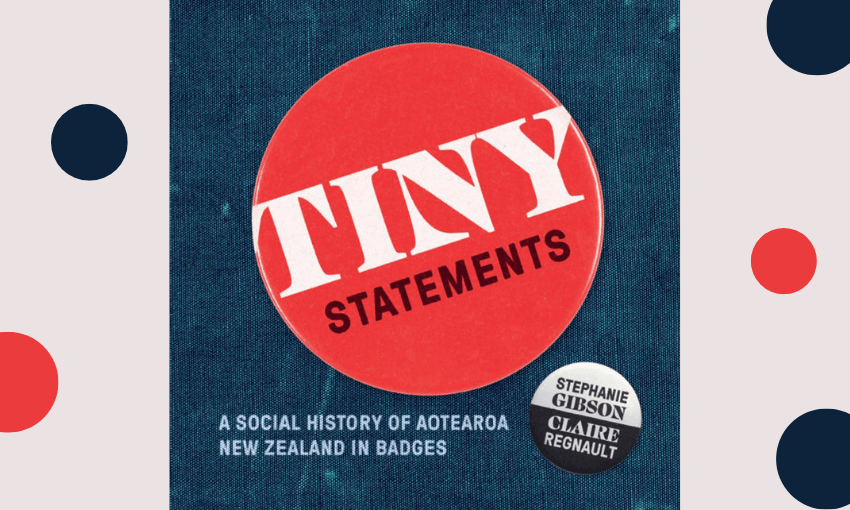Stephanie Gibson and Claire Regnault’s new book is a treasure trove of Aotearoa history, people and place, told through the medium of the badge. These excerpts are a few of our favourite, from the literary to the land march.
Margaret’s Magical Scarf
Margaret Mahy (1936–2012), the celebrated author of books for children and young adults, wore this badge adorned scarf when she gave readings in schools and libraries. The scarf bears the many badges that Mahy picked up during her travels. Not surprisingly, they celebrate the power of books.
A Scholastic book badge simply states “Reading counts”, and other badges encourage people to “Be a read-a saurus”, “Make a book date” and “Buzz to your library”; they announce that “Books are bewitching”, “take you higher” and that “Happiness is a good book”.
A host of well-loved children’s characters also populate the scarf, from Lewis Carroll’s Alice and Beatrix Potter’s Mrs Tiggy-Winkle to Jill Marshall’s “sensational spylet” Jane Blonde, and the elusive smiling lion from Mahy’s own children’s classic A Lion in the Meadow.
Most of Mahy’s scarf badges testify to her life with books, but they also hint at other interests, including two fan badges for the World Wrestling Federation stars Ravishing Rick Rude and “Macho Man” Randy Savage.
The Fiery Canoe: Teresia Teaiwa (1968–2017)
Badges are an effective way to carry a tiny portrait of a loved one near one’s heart. Such badges are a particularly important part of remembrance culture among Pacific communities, and are sometimes worn on lanyards around the neck.
This badge is both a memorial and an acknowledgement of a significant legacy in education in Aotearoa and the Pacific. Teresia Teaiwa (1968–2017), born in Hawai’i, was of Banaban, I-Kiribati and African American heritage. She founded the Pacific Studies programme (PASI) at Victoria University of Wellington in 2000, eventually becoming the director of Va‘aomanū Pasifika (Pacific Studies and Samoan Studies), and posthumously associate professor. Teaiwa (whose name can mean the “fiery canoe”) was a renowned scholar, activist and poet, influential throughout the Pacific region.
The design of the badge was based on a photograph of Teaiwa which showed one of her typical hairstyles and Pacific earrings (she would always wear at least one thing from the Pacific every day). Behind her is a rebbelib, a Marshallese navigational stick chart she owned. The silhouette concept was inspired by iconic images of American activist Angela Davis – one of Teaiwa’s academic supervisors and a friend – with her afro hair style.
Walking the whenua
Hīkoi (walk, march) was a long-established tradition for Māori, in which walking the boundaries of their districts helped people learn which whenua (land) belonged to them. In the 20th century, hīkoi became a key protest strategy for Māori fighting for their lands. In 1975, the Māori Land March left Te Hāpua in the far north to march to Parliament in Wellington. Organised by Te Rōpū Matakite o Aotearoa (“those with foresight”), the march called for “not one more acre of Māori land” to be lost. It was led by Whina Cooper (Te Rarawa, 1895–1994), who presented a petition to the government signed by 200 Māori kaumātua (elders) and 60,000 people. The march brought Māori concerns about land loss into the wider public awareness. Not long after, the Treaty of Waitangi Act 1975 was passed, enabling breaches of the Treaty to be investigated.
In 2004, a hīkoi opposing the Foreshore and Seabed Act also left Northland for Parliament. The legislation enabled the Crown to own New Zealand’s foreshore and seabed, which was seen by many as a breach of te Tiriti o Waitangi. The badge “No raupatu in our time” refers to when Māori land was forcibly confiscated (raupatu) as a result of the New Zealand Wars of the 1860s.
‘Power to the people’
In the 1970s, the New Zealand government promised to “get tough” on law and order and immigration. Raids took place in the early hours of the morning or late at night, when police would enter homes or stop people in the street to find so-called ‘overstayers’ – visitors from overseas whose work permits had expired. These dawn raids, as they came to be known, mostly targeted Pacific people, despite the majority of overstayers being British, Australian and South African.
These badges commemorate the fiftieth anniversary of the founding of the Polynesian Panther Party by young urban Pacific and Māori activists in June 1971. They were inspired by the Black Panther Party for Self-Defense in the United States (founded in 1966), and adopted similar iconography: berets, black clothing and leather jackets, clenched fists, and the leaping panther symbol.
The Polynesian Panthers aimed to highlight the needs of New Zealand’s growing Pacific communities, and the racism and discrimination they experienced, including harassment by police. They informed people of their legal rights, advocated for tenants, ran food co-ops and homework centres, helped with prison visits, promoted Pacific languages and supported Māori protests. The government formally apologised for the dawn raids in 2021.
Tiny Statements: A social history of Aotearoa New Zealand in badges by Stephanie Gibson and Claire Regnault (Te Papa Press, $40) can be purchased from Unity Books Auckland and Wellington.



